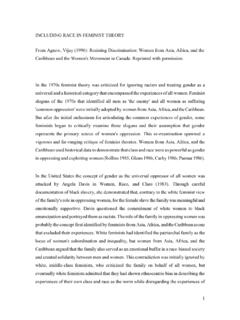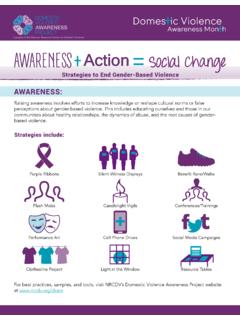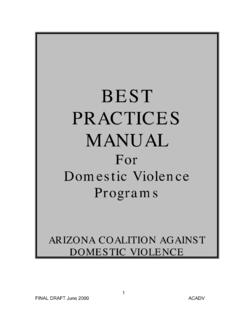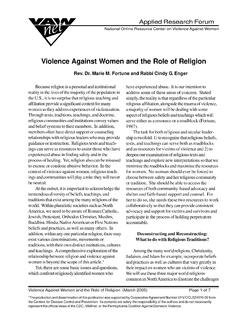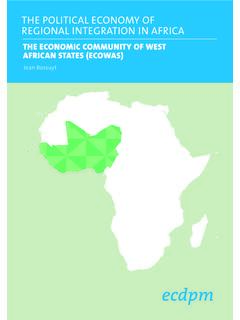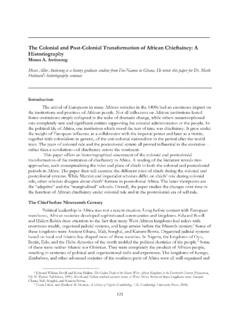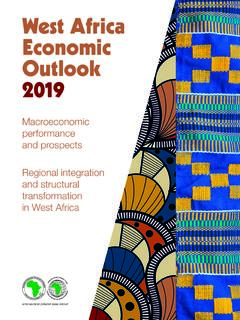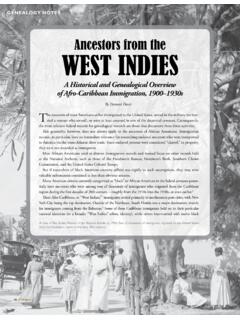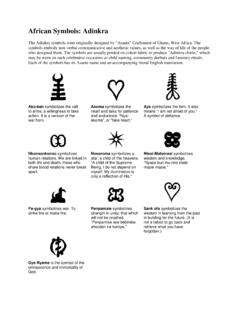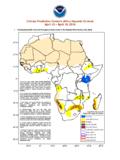Transcription of Sexual Violence in the Lives of African American Women
1 Sexual Violence in the Lives of African American Women Carolyn M. west and Kalimah JohnsonMarch 2013 Page 1 of 14 Applied ResearchApplied Research papers synthesize and interpret current research on Violence against Women , offering a review of the literature and implications for policy and Applied Research initiative represents a collaboration between the National Resource Center on Domestic Violence , the National Sexual Violence Resource Center, and the Minnesota Center Against Violence and is a project of the National Resource Center on Domestic Violence . Black Women were and continue to be sorely in need of an antirape movement. Angela Davis (1989, p. 44)According to the 2010 Census, (42 million) of the population self-identified as Black or African American1 (Rastogi, Johnson, Hoeffel, & Drewery, 2011). African Americans reported substantial rates of criminal victimization, including domestic Violence , assault, and robbery (Truman & Planty, 2012).
2 Furthermore, Black Women s Sexual victimization has occurred in a unique sociohistorical context. Accordingly, in the first section we will provide a historical overview. Next, we will discuss the characteristics of Black rape survivors2 and the environment in which their assaults occurred. In addition, we will identify risk factors that elevate Black Women s vulnerability to rape and review the physical and mental health problems that are associated with their victimization. To conclude, we will offer culturally sensitive techniques that can be used by professionals and highlight the resilience of African American OverviewThe institutional pattern of rape was well established before the newly enslaved Africans reached the Americas. During the transatlantic voyage, crew members routinely raped and impregnated Black Women . In preparation for sale, enslaved Women were stripped naked and placed on auction blocks. African American Women s economic 1 African American and Black will be used interchangeably.
3 With an influx of immigrants, more Black Americans trace their origins to African and Caribbean nations. Readers should ask survivors how they self-identify. 2 The terms victim and survivor will be used interchangeably to describe the recipient of Sexual Violence . value was dependent upon their ability to reproduce healthy offspring, which could be sold to increase the slave owner s wealth. According to historians, at least 58% of enslaved Women between the ages of 15 and 30 had been sexually assaulted by White men. After slavery ended, the Klu Klux Klan and other White vigilante groups whipped African Americans, destroyed their property, and gang raped Black Women (Sommerville, 2004). Rape laws did not provide equal protection for all Women . In fact, during the 1800s some rape laws were race-specific. For example, a rapist was defined as a man who unlawfully and carnally know [sic] any white woman against her will or consent (Sommerville, 2004, p.)
4 148). Lynching, castration, and incarceration were possible penalties for a Black man who was accused or convicted of raping a White woman. In contrast, there were no legal sanctions for White men who raped Black Women . Also, the legal system did not punish intraracial rape. In 1859, a Mississippi judge overturned the conviction of an older slave who had raped a slave girl who was under the age of 10. The defense attorney argued: The crime of rape does not exist in this State between African intercourse is promiscuous (Sommerville, 2004, p. 65). Embedded in this court decision, and embraced by the larger culture for more than 500 years, was the belief that Black Women s innate hypersexuality made them unrapeable and undeserving of protection or sympathy (Tillet & Quinn, 2007).Throughout history, African American Women have used a variety of resistance strategies to combat Sexual victimization. Some Women physically fought back or ran away.
5 Other Women developed a culture of silence that discouraged the disclosure of rape. This code of secrecy often extended to the larger Black community (Sommerville, 2004). In the 1870s, Ida B. Wells and other activists protested the lynching of Black men based on false rape accusations and challenged the stereotype that depicted Black Women as promiscuous Jezebels3 who invited Sexual assault. Anti-rape organizing, as part of the larger civil rights movement, continued during World War II and into the 1970s. Rosa Parks and other activists protested against Sexual assault that was perpetrated against Black Women in their communities, on public transportation, and within White households where Black Women worked as domestic servants (McGuire, 2010). Today, a multiracial coalition of advocates have continued this work by addressing racism in the anti-rape movement and unpacking the interconnections between rape and other forms of oppression (Washington Coalition of Sexual Assault Programs, 2007).
6 Characteristics of Survivors and AssaultsSurvivors may experience various forms of Sexual victimization across their lifespan. Defined as incest, rape4, or Sexual coercion before age 18, childhood Sexual abuse (CSA) has been documented in community samples of Black Women recruited from Boston ( ) (Amodeo, Griffin, Fassler, Clay, & Ellis, 2006) and Chicago (65%) (Bryant-Davis, Ullman, Tsong, Tillman, & Smith, 2010). Similarly, high rates of CSA were reported in a predominately Black sample of female veterans (59%) (Campbell, Greeson, Bybee, & Raj, 2008) and in a sample of HIV positive (67%) and Sexual Violence in the Lives of African American Women (March 2013) Page 2 of 14 Applied Research3 For a historical and contemporary overview of the Jezebel image, see west (2009). 4 For clarity, rape is completed or attempted unwanted vaginal, oral, or anal penetration achieved through physical force, threats, or the use of alcohol/drugs. Sexual coercion is unwanted Sexual penetration that is achieved through nonphysical pressure ( , repeatedly asked for sex, misuse of authority).
7 Unwanted Sexual contact is Sexual touching, such as forced kissing and fondling (Black et al., 2011). Sexual Violence in the Lives of African American Women (March 2013) Page 3 of 14 Applied ResearchHIV negative (60%) Black Women who were recruited from four major cities (The NIMH Multisite HIV/STD Prevention Trial for African American Couples Group, 2010). Commercial Sexual exploitation of children (CSEC) is a form of child Sexual abuse that has gained recent recognition. It involves sex trafficking or profiting from a minor sinvolvement in sex acts, such as prostitution, pornography, or stripping. In a sample of Black Women with documented histories of CSA, 12% had been prostituted and forced to exchange sex for money before the age of 18 (Reid, 2011). A substantial number of Black teenage girls also reported Sexual victimization. Among students, of Black girls in a national high school sample reported have been raped (Thompson, McGee, & Mays, 2012), 52% of a Black midwestern high school and college students reported Sexual coercion (French & Neville, 2008), and of Black Women who were enrolled in historically Black colleges and universities (HBCUs) reported a completed or attempted rape (Krebs, Lindquist, & Barrick, 2011).
8 In a longitudinal study of young African American Women (ages 15-21) who sought Sexual health services at urban clinics, were rape victims. When the study ended 12 months later, an additional of the nonvictimized participants had been raped (Lang et al., 2011). In adulthood, approximately 1 in 5 African American Women reported that they had been raped at some point in their lifetime. More specifically, of Black Women in the National Violence Against Women Survey (NVAWS) (Tjaden & Thoennes, 2006) and 22% of the Black Women in the National Intimate Partner and Sexual Violence Survey (NISVS) reported a lifetime rape. Also, the NISVS revealed that 41% of Black Women experienced Sexual coercion and other forms of unwanted Sexual contact. These prevalence rates translate to an estimated million Black rape victims and million Black survivors of other forms of Sexual Violence (Black et al., 2011). There is a great deal of diversity among African American Women .
9 Consequently, some groups are especially vulnerable to Sexual victimization, including Black Women who are low-income, are living with HIV, who identify as Sexual minorities, and who are incarcerated. For instance, of Black Women in a low-income Dallas sample had been sexually assaulted (Temple, Weston, Rodriguez, & Marshall, 2007). HIV-positive Black Women ( ) were significantly more likely to have a history of adult Sexual assault than HIV-negative Black Women ( ) (The NIMH Multisite HIV/STD Prevention Trial for African American Couples Group, 2010). When compared to Black college Women who identified as heterosexual ( ), those who identified as bisexual ( ) reported higher rates of Sexual assault (Krebs et al., 2011). Incarcerated at between 2 and 3 times the rate of White Women , Black Women are overrepresented in the criminal legal system. Depending on the study, more than half of incarcerated Women were raped or experienced CSA before coming to prison.
10 While in custody, Women may be strip searched, subjected to sexualized surveillance ( , being watched in the shower), or be pressured to provide Sexual favors in exchange for privileges or access to resources, such as food or telephone calls (VanNatta, 2010-2011). In most cases, Sexual Violence was an intraracial crime ( , of Black college Women were raped by Black men) (Krebs et al., 2011). Most often the perpetrator was someone known to the victim ( , 75% of Black Women in a Chicago sample knew their rapist) (Long, Ullman, Starzynski, Long, & Mason, 2007). Among Black CSA survivors who were raised in Sexual Violence in the Lives of African American Women (March 2013) Page 4 of 14 Applied Researchtwo-parent families, were victimized by a household member. Although 28% were victims of incest, living with a step-father was not associated with higher rates of CSA (Amodeo et al., 2006). Intimate partners also were frequently identified as Sexual offenders.
